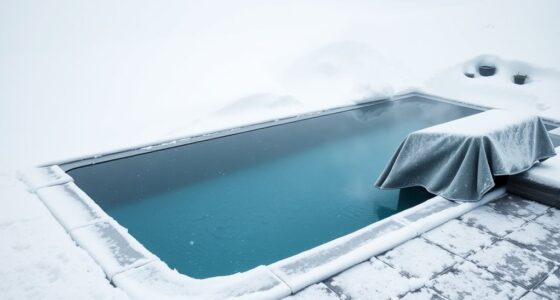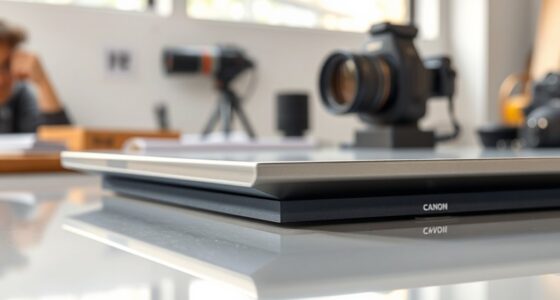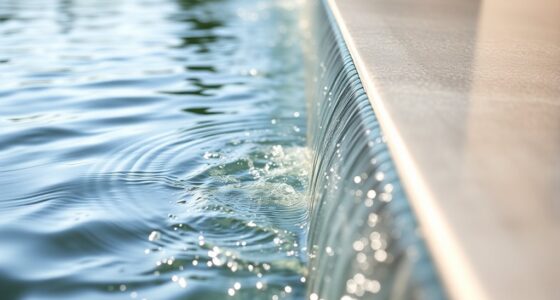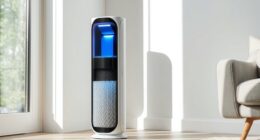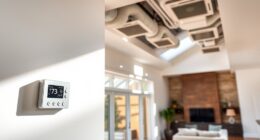When adding fire features to your infinity edge pool, safety depends on proper clearances—at least 3 feet from combustible objects and 6 inches from spillways. Managing heat involves good ventilation, heat shields, and adjustable flames while keeping soot levels low requires high-quality fuel and regular cleaning. To prevent smoke buildup, guarantee proper airflow and routine inspections. If you want to learn how to balance fire, water, and safety effectively, keep exploring these essential guidelines.
Key Takeaways
- Maintain minimum safety clearances of 3 feet around fire features and 18 inches from pool edges.
- Use fire-resistant materials and proper venting to manage heat and prevent soot buildup.
- Implement adjustable flames and heat shields to control temperature and improve safety.
- Ensure adequate ventilation to reduce smoke, vapor, and soot accumulation during operation.
- Regularly inspect and clean fire features, using high-quality, dry fuel for cleaner combustion.
Understanding the Interaction Between Water and Fire Elements

While water and fire are often seen as opposing forces, understanding how they interact can enhance the design of your outdoor space. Water’s calming presence contrasts sharply with fire’s energetic glow, yet combining them creates striking visual effects. Fire features can be built into or placed near water elements, such as infinity pools or fountains, to amplify their beauty. However, it’s essential to consider how these elements influence each other—water can dampen fire’s intensity, while fire can cause steam or vapor that affects water clarity. Proper placement and materials ensure safety and durability. Additionally, understanding water quality and flow rate is crucial when integrating these features to prevent issues like vapor buildup or water contamination. By thoughtfully integrating water and fire, you create a dynamic environment that balances tranquility with drama, making your outdoor space both captivating and harmonious.
Managing Heat Output for Safety and Comfort

To keep your fire feature safe and comfortable, you’ll need effective ventilation strategies that prevent heat buildup. Temperature regulation techniques, like using shields or adjustable flames, help maintain a pleasant environment. Implementing these measures guarantees your fire element enhances your space without compromising safety. Additionally, proper placement of the fire feature, considering clearance zones and surrounding materials, is crucial for minimizing fire hazards and ensuring optimal room airflow.
Ventilation Strategies for Safety
Effective ventilation is essential to managing heat output from Infinity Edge fire features, ensuring both safety and comfort. Proper airflow prevents excessive heat buildup that could damage surrounding materials or pose burn risks. You should design ventilation systems that promote continuous air exchange, such as incorporating vents, exhaust fans, or open spaces near the fire feature. Position vents strategically to direct hot air away from seating areas and equipment. Regularly inspect and clean ventilation components to maintain efficiency. Additionally, consider the placement of the fire feature in relation to existing ventilation pathways to maximize airflow. Adequate ventilation not only reduces the risk of overheating but also minimizes soot accumulation and improves overall air quality around your fire feature. Incorporating ventilation strategies like these can significantly improve safety and efficiency in managing heat output.
Temperature Regulation Techniques
Managing heat output from your Infinity Edge fire features is essential for ensuring safety and maintaining comfort. You can achieve this by installing adjustable flame controls, allowing you to regulate the intensity of the fire. Using a combination of tempered glass panels and strategic placement helps contain heat and prevent accidental burns. Incorporate heat shields or reflectors to direct warmth away from seating areas, creating a more comfortable environment. Regularly monitoring the fire’s temperature with a thermometer ensures it stays within safe limits. Additionally, choosing the right fuel type and size of the fire feature influences heat output, giving you better control. Understanding the contrast ratio of your fire feature can help manage perceived brightness and heat levels, contributing to a safer setup. By applying these techniques, you keep your space safe, cozy, and inviting, without risking overheating or discomfort.
Soot Production: Causes and Prevention Strategies

Soot production from Infinity Edge and fire features occurs primarily when combustion is incomplete, often due to poor airflow or improper fuel-to-air ratios. When combustion isn’t efficient, you’ll notice more soot and smoke, which can stain surfaces and reduce air quality. To prevent this, ensure proper ventilation and maintain correct fuel ratios. Using high-quality, dry fuel also minimizes soot. Regularly cleaning your fire feature and adjusting airflow can improve combustion, reducing soot buildup. Additionally, monitoring airflow management can help maintain optimal combustion conditions.
Selecting the Right Fire Features for Infinity Edge Pools

When choosing fire features for your infinity edge pool, safety and clearance are top priorities to prevent accidents. You’ll also want to contemplate how well the fire element manages heat and soot to keep your space clean and comfortable. By focusing on these factors, you can select fire features that enhance your pool’s beauty without compromising safety or cleanliness. Understanding decoding modern slang can also help in communicating effectively with vendors and designers about your needs.
Safety and Clearance Needs
Choosing fire features for your infinity edge pool requires careful attention to safety and clearance requirements to prevent accidents. You must guarantee there’s enough space around the fire feature, typically at least three feet, to reduce fire risk. Keep combustible materials away from the flames, and install barriers or screens if needed. Always select fire features rated for outdoor use and designed with safety in mind. Proper placement is vital; avoid placing fire features near the pool edge or where wind could blow flames or sparks. Make sure you have appropriate safety equipment nearby, like fire extinguishers. Consulting local codes and regulations is essential to confirm compliance and safety. Prioritizing these needs helps you enjoy your fire feature safely without compromising your pool’s aesthetic or functionality. Additionally, understanding the importance of environmental considerations can help you select options that minimize ecological impact and promote sustainable outdoor living.
Heat and Soot Management
Selecting fire features that effectively manage heat and soot is essential for maintaining the beauty and safety of your infinity edge pool. Proper choices prevent overheating nearby surfaces and reduce soot buildup, keeping your pool area clean and inviting. Consider fire features with adjustable flame height. Use designs that direct smoke away from water. Incorporate proper ventilation systems. Select fuel types that produce less soot, like natural gas. Schedule routine cleaning to prevent soot buildup. Ensuring proper air circulation can also significantly improve soot management and overall safety.
Proper Clearances and Spacing Requirements

Ensuring proper clearances and spacing is essential for both safety and ideal performance of your Infinity Edge and fire features. Maintaining the right distances prevents heat damage, reduces fire risks, and optimizes the visual effect. Always follow manufacturer guidelines, which typically specify minimum distances between flames, edges, and combustible materials. Keep flammable objects at least 3 feet away from the fire feature. For structural safety, allow at least 12 inches of clearance from any surrounding surfaces. Use the table below to visualize common spacing requirements:
| Feature Component | Minimum Clearance | Notes |
|---|---|---|
| Fire pit to combustible surface | 12 inches | Prevents heat damage |
| Flames to edges | 18 inches | Ensures safety |
| Combustible objects | 3 feet | Reduces fire risk |
| Infinity Edge spillway | 6 inches | Maintains proper flow |
Additionally, proper spacing helps in maintaining the aesthetic appeal and ensures the longevity of your fire features.
Ventilation and Airflow Considerations

Proper ventilation and airflow are essential for the safe and efficient operation of your Infinity Edge and fire features. Without proper airflow, you risk smoke buildup, poor combustion, and increased soot accumulation. Ensuring adequate ventilation helps prevent dangerous fumes and maintains ideal combustion efficiency. You should consider the placement of vents, fans, and exhaust systems to facilitate continuous airflow. Regularly inspect these components for blockages or damage. Proper airflow also reduces heat buildup around the fire feature, protecting nearby surfaces. Adequate ventilation is especially vital in enclosed or semi-enclosed spaces. Failing to maintain good airflow can compromise safety and cause operational issues. Additionally, understanding the weight of your fire features is important for safe installation and maintenance.
Materials and Construction Tips for Safe Installation

Using the right materials and construction techniques is essential for installing your Infinity Edge and fire features safely and effectively. Choose fire-resistant materials like concrete, steel, or fire-rated stone to withstand high temperatures and prevent damage. Ensure your fire pit or burner is built with proper clearances from combustible surfaces, following manufacturer guidelines and local codes. Use high-quality, heat-resistant sealants and fireproof barriers to contain heat and prevent soot buildup. Incorporate a sturdy, level foundation to support the weight and prevent shifting over time. Properly vent the fire feature to avoid heat trapping and ensure safe operation. Double-check all connections and fittings for leaks or instability before finalizing installation. These precautions help reduce fire hazards and promote long-term durability.
Maintenance Practices to Minimize Soot and Heat Risks

Regular maintenance is key to minimizing soot buildup and controlling heat risks with your Infinity Edge and fire features. Consistent cleaning prevents soot accumulation on surfaces and ensures proper airflow, reducing fire hazards. Check your system regularly for any blockages or debris that could cause uneven combustion or excessive heat. Adjust your fuel mixture as needed to promote cleaner burns, and monitor the fire’s activity to identify any irregularities early. Additionally, inspect and clean burners and vents to maintain efficient operation.
Regularly clean and inspect your fire features to prevent soot buildup and ensure safe, efficient operation.
- Clean soot and debris from burners and surrounding areas
- Regularly inspect and replace worn or damaged parts
- Adjust fuel-to-air ratios for cleaner combustion
- Keep fire glass or media free of soot buildup
- Schedule professional inspections annually
Design Ideas for Harmonious Water and Fire Integration

Creating a seamless water and fire feature begins with thoughtful design that balances both elements visually and functionally. To achieve harmony, consider pairing a sleek infinity edge pool with a fire feature that complements its lines, like a linear fire pit or a floating flame. Use materials and colors that blend naturally, such as stone or metal, to unify the design. Position fire elements where they won’t obstruct views or create safety hazards, ideally near the pool’s edges for easy access and visual connection. Incorporate lighting that enhances both water and fire features, creating a warm, inviting atmosphere at night. Keep scale and proportion in mind to prevent one element from overpowering the other, ensuring both water and fire work together to create a balanced, mesmerizing focal point.
Regulatory Codes and Safety Standards to Follow

Before installing fire features, you need to understand your local fire regulations to ensure compliance. Make sure to follow clearance distance requirements to keep everyone safe, and verify proper ventilation for safe operation. Ignoring these standards can lead to hazards or legal issues, so it’s vital to prioritize safety and code adherence.
Local Fire Regulations
Understanding and complying with local fire regulations is essential when installing fire features like Infinity Edge pools and fire pits. These regulations vary by area and may specify permitted fuel types, installation methods, and safety measures. Failing to follow them can lead to fines, safety hazards, or legal issues. You should check with your local fire department or building authority before proceeding.
- Obtain necessary permits and approvals before installation
- Use approved fire-resistant materials and components
- Follow guidelines for proper venting and ventilation
- Limit fire feature size and fuel type as per local rules
- Schedule inspections during and after installation to ensure conformity
Clearance Distance Requirements
Have you checked the clearance distance requirements outlined by regulatory codes and safety standards before installing your fire features? Ensuring proper clearances is essential for safety and compliance. Most codes specify minimum distances between your fire feature and combustible materials, structures, or flammable objects. These distances vary depending on the type of fire feature, its size, and fuel source. For example, gas fire pits often require larger clearances than electric or ethanol models. Always review local building codes, manufacturer instructions, and safety standards to determine the exact measurements needed. Failing to meet these requirements can lead to fire hazards, code violations, or insurance issues. Measure carefully and position your fire feature accordingly before proceeding with installation. Proper clearances protect you, your property, and everyone around you.
Ventilation and Safety
Ensuring proper ventilation and adhering to safety standards are crucial steps when installing fire features, as inadequate airflow can lead to dangerous buildup of fumes or heat. You must follow local building codes and manufacturer instructions to prevent hazards. Proper ventilation helps eliminate smoke, fumes, and excess heat, reducing fire risks. Additionally, installing carbon monoxide detectors and fire extinguishers nearby enhances safety. Always consider clearance zones around the fire feature and avoid combustible materials nearby. Regular inspections ensure ventilation systems function correctly.
- Verify compliance with local regulations and permits
- Use approved ventilation systems for indoor installations
- Install sensors for smoke and carbon monoxide detection
- Maintain clear access for emergency response
- Schedule routine safety inspections and maintenance
Frequently Asked Questions
How Do Different Fire Feature Types Affect Pool Safety?
Different fire feature types impact pool safety in various ways. Gas or propane fire pits pose risks of leaks, explosions, and burns if not properly maintained. Electric or bioethanol fire features reduce some hazards but still require clearances and supervision. Always keep fire features away from pool edges, use protective barriers, and follow manufacturer instructions. Regular inspections and safety precautions guarantee your fire features enhance ambiance without compromising safety.
What Are the Long-Term Maintenance Costs for Fire and Water Features?
You’ll find that maintaining fire and water features can be affordable over time. Regular cleaning, such as removing soot and debris, prevents costly repairs, while monitoring fuel levels and electrical components keeps everything running smoothly. Investing in quality equipment reduces long-term costs, and routine service checks help avoid major issues. With proper upkeep, your features stay beautiful and safe without draining your budget.
Can Fire Features Be Integrated Into Existing Infinity Edge Pools?
Yes, fire features can be integrated into existing infinity edge pools, but you’ll need to work with a professional to guarantee proper installation. They’ll assess your pool’s structure, electrical supply, and safety clearances. Expect some modifications to accommodate the fire element, and be prepared for ongoing maintenance costs like cleaning, inspections, and safety checks. Proper planning ensures your fire feature enhances your pool’s beauty without compromising safety or functionality.
How Do Climate Conditions Influence Fire Feature Performance?
Climate conditions definitely influence fire feature performance, though it’s amusing how many overlook this. In windy weather, flames flicker wildly, risking safety and extinguishing easily. Cold temperatures can dampen flames, making them harder to ignite or sustain. Humidity and rain are the ultimate party crashers, snuffing out fires when you least expect it. So, if you want your fire features to perform reliably, consider your local climate and plan accordingly—fire isn’t always the most obedient guest.
Are There Eco-Friendly Options for Fire and Heat Generation?
Yes, there are eco-friendly options for fire and heat generation. You can choose bioethanol fireplaces, which burn renewable alcohol-based fuels and produce minimal emissions. Alternatively, solar-powered heating systems harness sunlight to generate warmth without any pollution. Using these sustainable choices helps reduce your carbon footprint while still providing cozy heat and ambiance. Consider these greener options to enjoy fire features responsibly and protect the environment.
Conclusion
So, go ahead and embrace the fiery allure of infinity edges with fire features—just remember, your pool’s new best friends are safety, planning, and a good sense of humor. Because nothing says “relaxing swim” like a controlled blaze with just a hint of soot and heat, right? With proper precautions and savvy choices, you’ll turn your backyard into a stunning oasis where fire and water play nicely—no need for a firefighter’s autograph just yet.



